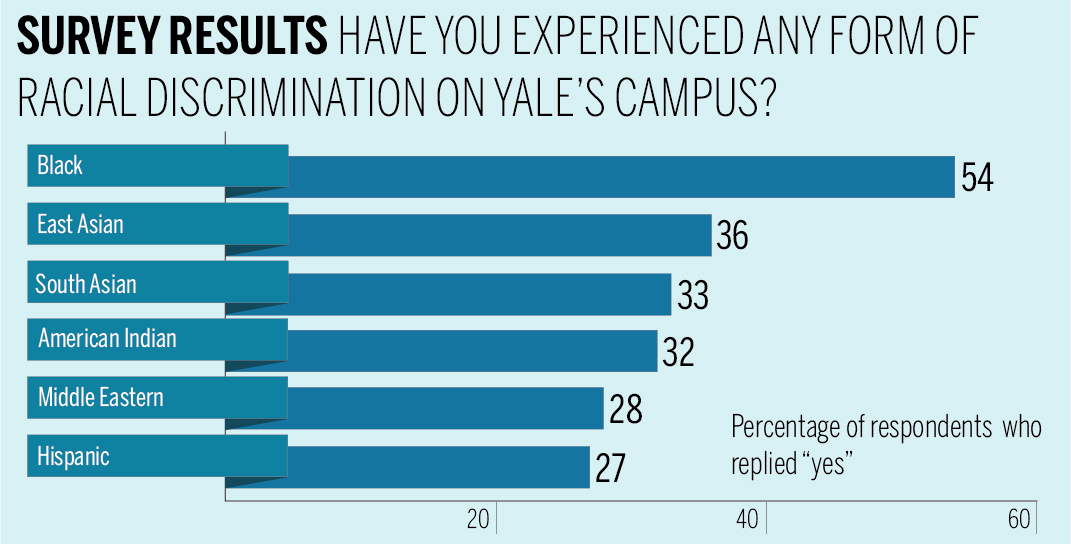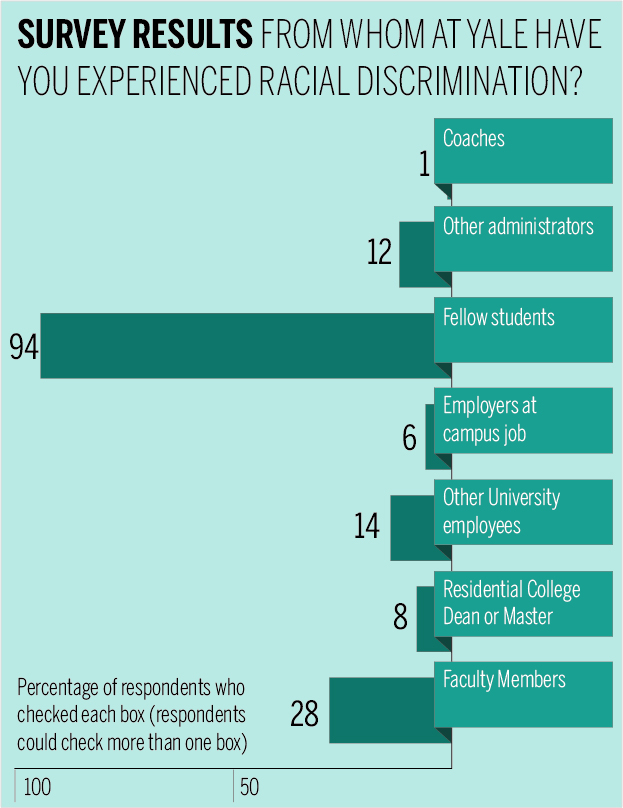
On Nov. 30, the News distributed a survey to all undergraduates about racial climate on campus and University President Peter Salovey’s recent policy responses. A comprehensive data set will be published online on Friday.
In the survey, students had the option of selecting one or more choices to represent their ethnic backgrounds. The ethnic breakdown of the 1,485 respondents very closely matches that of the student body as a whole. According to the Office of Institutional Research, at Yale, 72 percent of students identify as White and Other, 20 percent as Asian, 9 percent as Black and 9 percent as Hispanic; of survey respondents, 67 percent identified as Caucasian, 20 percent as Asian, 9 percent as Black and 12 percent as Hispanic.
When recounting where and from whom they had experienced racial discrimination at Yale, affected students had the ability to submit multiple responses. The survey data conveys two stark realities: Students of color experience racial discrimination at much higher rates and their peers are usually responsible for those experiences. The most affected group is Black women: 58 percent said they have experienced racial discrimination while at Yale.
In reporting the one or more parties from whom they had experienced discrimination at Yale, 94 percent of respondents cited their peers, 28 percent cited faculty members, 14 percent cited University employees and 8 percent cited their residential college dean or master.
Students were also asked to describe the one or more places at Yale where they had been racially discriminated against: 60 percent of respondents who said they had been subject to discrimination said it had occurred in on-campus social settings, 45 percent identified their residential colleges and 42 percent identified off-campus social settings, including Greek life spaces. Additionally, 40 percent reported experiencing discriminatory behavior in the classroom and 34 percent in extracurricular settings.
One female Black student gave the News permission to include her answer to an open-response section inviting respondents to elaborate on racially discriminatory experiences they have had at Yale.
“The most persistent form of discrimination I have felt at Yale was in a creative writing seminar last year, when any work that I or another black writer submitted that addressed race seemed to be quickly categorized by the professor as political or activist ‘art,’” she wrote. “I felt uncomfortable by the end of the semester with bringing in pieces that mentioned race or other social identities/issues at all.”
While 20 percent of all respondents said they have experienced racial discrimination while at Yale, students of color reported significantly higher rates: 40 percent said they have personally been racially discriminated against at Yale. Specifically, 54 percent of Black students said they have been racially discriminated against at Yale, as compared to 36 percent of East Asians, 33 percent of South Asians, 32 percent of American Indians or Alaska Natives, 28 percent of Arab-Americans and Middle Easterners and 27 percent of Hispanic students.
Still, 60 percent of students of color said they had not experienced any form of racial discrimination while at Yale.
Christian Conway ’18, who is Black, said he has not been subject to racial discrimination at Yale.
“I can only speak for myself, but in my time here I cannot say that I have experienced any sort of discrimination based on the color of my skin,” he said. “It’s entirely possible something someone said might be of poor word choice but I don’t think that amounts to racial discrimination. It’s all about interpretation.”
Survey respondents also spoke of the impact the events of the past month-and-a-half have had on campus climate. In the survey and in follow-up interviews with the News, students expressed mixed opinions on the subject. Some said recent events have fostered healthy discussion amongst students. Others said they have divided campus. Many said both.
Fish Stark ’17, who is Caucasian, said recent events have been a “time of unity” for students, demonstrated by massive participation in events like the March of Resilience.
Dasia Moore ’18, a Black student, said though the recent weeks have been emotionally tiring, they are also helping create a better Yale.
“I think that the recent events have really opened up a conversation that is long overdue, one that recognizes the unequal ways in which students experience Yale,” she said. “The racial climate to me seems more present, but also more honest. As a freshman, I often felt suffocated and unable to understand, articulate and share with others the way race was impacting my time at Yale. Now, I feel I can breathe a little more. However emotionally exhausting sharing painful experiences may be, it is less tiring than silencing yourself.”
Conway said the campus community has become less welcoming to potentially controversial viewpoints, specifically citing Silliman College Associate Master Erika Christakis’ decision to not teach at Yale in the spring.
Duncan Tomlin ’16, a Caucasian student, said he has noticed conflicting mentalities on campus concerning the value of debate and engagement amongst students.
“There is a really big divide on campus, and it’s not something people are talking about,” Tomlin said. “Some people believe an idea or argument becomes stronger in the face of opposition, and some believe that an argument is stronger in the absence of opposition.”
Still, Lillie Lainoff ’18, who is Caucasian, said she is glad the student-led movement confronted hidden issues on campus, adding that feelings of division are inevitable components of such movements.
In response to the survey results, University President Peter Salovey told the News that Yale must continue working to foster a more inclusive environment on campus.
“This is a conversation about race, a conversation about gender and a conversation about various intersections of social identities. We need to always be thinking about these issues and always be open to ways to increase inclusion,” he said.








